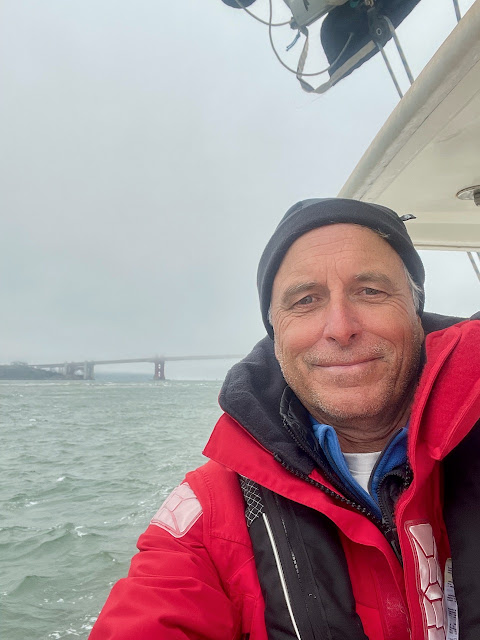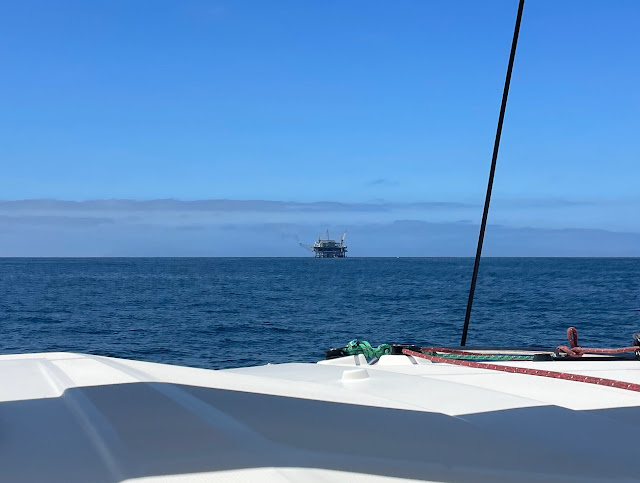Isla San Francisco, Sea of Cortez
We’re anchored just off the beach of beautiful Isla San Francisco. I spent yesterday morning resting, after the overnight passage here from Puerto Escondido, and the afternoon doing boat chores and troubleshooting the not-working Multi Function Device (MFD, aka chartplotter). I had a nice swim in between.
The passage here was uneventful. Forecast westerly and northwesterly winds never materialized (surprised?) which would have allowed us to sail. Instead it was motoring, again. Particularly painful after shelling out $400 for diesel in Puerto Escondido to refill the tanks; 230 liters (61 gallons) burned getting there from Puerto Peñasco. Diesel fuel in Mexico is over $6 per gallon, thanks to a mostly nationalized petroleum industry, virtually no competition and price fixing, all of which are exacerbated at marine fuel docks. If only the atmosphere would cooperate with my sailing plans, I would put far less CO2 into it and save money.
I had to navigate and pilot Intermezzo differently on the trip here due to the balky MFD. It wasn’t difficult or risky, just different, like borrowing someone else’s computer. It works fine, does the job, but isn’t set up like yours is. I supplemented the working MFD with the independent Navionics navigation app on my iPad. I had to transfer the positions of waypoints manually, but that was really the only difference and I got comfortable with the improvised system by mid-journey.
The funny thing is that I have sailed this route at least a half-dozen times. It runs between the Baja peninsula and off-lying islands, so lots of landmarks to navigate by and the few hazards are easily located and avoided. On top of that, a waxing gibbous moon was out and providing plenty of light by which to navigate. So I really didn’t need any electronic devices. I didn’t even need a compass. I could have safely navigated here with just a paper chart and my eyeballs. My angst over one (of four) electronic navigation devices being down is clearly a symptom of Electronic Device Dependency (EDD), a diagnosis I propose be added to the Diagnosis and Statistical Manual of Mental Disorders (the infamous DSM).
The good news is that I diagnosed and fixed the malfunctioning MFD, providing symptomatic relief of my angst though not my EDD. Finding the solution was not a straightforward process. I’ll briefly summarize the steps I took to paint a picture of the winding path.
Intermezzo has two MFDs, MFD 1 and MFD 2. MFD 1 would not boot up and function, MFD 2 was working properly. Since I have a spare MFD, I swapped it in for MFD 1; it didn’t boot up either. So, I reinstalled MFD 1 to maintain constant conditions. The MFDs are connected to each other and the radar through a network switch. The switch was receiving data from all three devices. I plugged the network cables into different sockets on the switch; no change. I visited the Raymarine online tech forum and found troubleshooting steps for the symptoms I was observing. Following these steps, I checked all the power connections to the devices and found no evidence of loose connections or corrosion. I unplugged the radar from the network; the problem persisted. I deleted track data; no change. The next steps would be to do factory resets on the devices; I wasn’t willing to take the risk of doing that and possibly messing up the working MFD 2 and radar. I put the troubleshooting steps aside and returned first principles of troubleshooting, basic logic.
I knew that MFD 2 worked by itself and with the radar. Would MFD 1 work by itself? I tried and it did, also playing nicely with radar. So that meant the problem must be in the communication between MFD 1 and MFD 2. But the network switch connecting seemed to be working and MFD 1’s screen showed me that some data was getting transferred between the two devices, even if MFD 1 wasn’t working right. Hmmmmmm…What changed since MFD 1 was last working properly? I had started running Starlink for an internet connection while underway, while the MFDs were on; hadn’t done that before. The refrigerator was recharged with refrigerant; that can cause the compressor to have to work harder, causing boat-wide voltage fluctuations. And I had updated the Navionics chart chip that provides cartography for the MFDs.
I turned the fridge off; no change. I turned Starlink off; no change. I removed the Navionics chart chip; both MFDs worked properly! (Albeit, without any cartography with seriously reduces their usefulness!) So, the chip was the problem. I updated the chip contents via the internet (thank you Starlink…I can’t bring myself to thanking Elon Musk), inserted it into MFD 2 and, voilà, we’re back in business!
Who would have thought that a chart chip installed in one device (MFD 2) would prevent another connected device from booting up? It’s as if you opened a word processor document on your computer and it stopped your printer from turning on. But further research online (Facebook, of all places!) reveals that, indeed, Navionics chips can stop Raymarine MFDs from booting up. I am not alone.
So that problem is solved. But I have a new one. (Surprised?)
When I went swimming yesterday, I dove under the boat to look at the props and sail drives. To my astonishment, the sacrificial anodes on the props are 50% gone in just nine days of being in the water! Usually it takes three or more months for them to get eaten up this much. Intermezzo clearly has a stray current problem. Unfortunately I lack a reference cell anode to check this. So I will need to be resourceful to find the leaking electricity. I can’t think of anything that has changed since we were last in the water, so this is a real puzzle.
Meanwhile, I am enjoying my surroundings. The weather is hot and humid during the day, but made bearable by staying in the shade, fans in the cabin and swimming. It cools off nicely at night. Very light or no breeze. The boat is covered in dew in the morning, much to the pleasure of the bees who come on board to drink it. I’ve learned to coexist with bees on the Sea of Cortez, I actually enjoy their visits, though I’m careful not to step on them, the only time I have ever been stung. I put out water for them where they won’t get in my way and they seem to enjoy the gesture and don’t bother me.
The seawater is crystal clear, I can see stingrays clearly on the bottom, 20 feet below the boat. A big school of juvenile fish is sheltering under the boat. There must not be food for pelicans because they aren’t here, but a pesky seagull is trying hard to claim the solar panels as his territory. There are a few other boats in the anchorage, including a large, ugly “party yacht”, complete with a water slide, but everyone is keeping quiet and civilized.
Today I’m going to head about halfway towards La Paz, stopping overnight in Bahía La Gallena at Isla Espíritu Santo, about four hours away. Less than two weeks left to enjoy the Sea of Cortez and then begin the Baja Bash. It’s going to be painful to say goodbye to this place that I love.





























